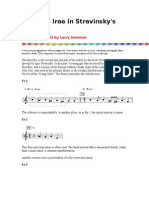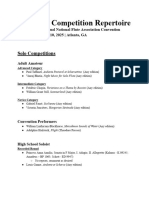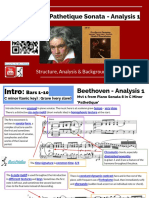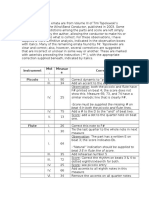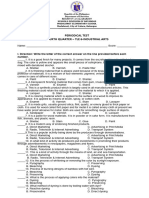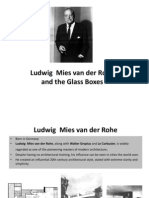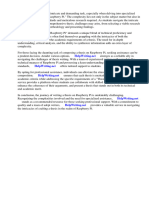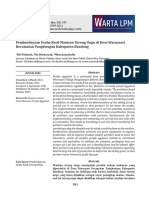Timed Analysis Project 1
Timed Analysis Project 1
Uploaded by
Tom BurnsCopyright:
Available Formats
Timed Analysis Project 1
Timed Analysis Project 1
Uploaded by
Tom BurnsOriginal Title
Copyright
Available Formats
Share this document
Did you find this document useful?
Is this content inappropriate?
Copyright:
Available Formats
Timed Analysis Project 1
Timed Analysis Project 1
Uploaded by
Tom BurnsCopyright:
Available Formats
Tom Burns: 130188722
MUS203: Analytical Approaches to Music
Timed Analysis Project 1:
Mozarts String Quartet No. 16 in Eb major (K.428), mvt. III
String quartet no. 16, composed in 1783, is the third of the Haydn
Quartets, a series of six string quartets Mozart wrote during his first few
years in Vienna (1782-1785), that were later dedicated to Joseph Haydn.
During the time of composition of these quartets, Haydn and Mozart had
become friends, and often played quartets together in Mozarts
apartment, Mozart on viola and Haydn on violin. All six of these string
quartets follow a similar basic form:
First movement Allegro in sonata form
Second movement Adagio or Andante in sonata form
Third movement Minuetto and Trio
Fourth movement Allegro in sonata, rondo or variation form
The second and third movements are often switched depending on the
quartet. K.428 is no exception to the structure of the Haydn Quartets.
The individual structure for the third movement is a very typical
form for a minuet and trio. On broad observations, it is essentially a
ternary structure with internal forms within each of the ternary sections
(see Fig. 1). There is however a passage that could be construed as a
codetta, as it contains melodic material not previously heard, and stays in
the home key in preparation to move, be it to the start of the minuet
again, or to begin the trio using the tonic chord as a pivot; the passage in
question occurs over bars 55 70, and will henceforth be described as a
codetta.
Fig. 1
The melodic material within the minuet can be separated into two
main identifiable themes (1 and 2), both of which are initially delivered by
the first violin. Theme 1 can then be divided into a further two sections (a
and b). Theme 1a (Fig. 2) is two bars long and consists of a very Haydnesque, almost sneezing, motif that covers nearly two octaves, leaping
up initially with a quick succession of two semi-quaver appogiaturas to a
tonic crotchet, with then drops to a minim on E flat. This pattern is then
Tom Burns: 130188722
MUS203: Analytical Approaches to Music
repeated only now ending on a minim on F. Theme 1b (Fig. 3) is double the
length of 1a and comprises of stately, flowing quavers. The second theme
(Fig. 4) of the minuet is very different to the first, with longer note values,
and the introduction of dotted notes, as well as much shorter note values
like the demi-semi-quavers in bar 12. There is much use of this thematic
material throughout the minuet, where it becomes subjected to antiphonal
exchange (1b delivered by the first violin then mimicked by the viola half
a bar later which does indeed occur during the second presentation of
this theme in bars 9 and 10) and extension (1a over bars 42 46).
Interestingly, all of these themes, even those in the trio, begin on an
anacrusis.
The melodic material in the trio only really comes from one main
theme (Fig. 5 abbreviation of whole theme), unlike the two (or three if
one counts the division of the first) of the minuet. With only one theme
present here, something must be done quite ingeniously in order to
maintain or even provoke interest throughout. This is accomplished by a
further reminiscence of Haydn, in that this trio is rather monothematic.
Beginning at bar 70 (on an anacrusis) and continuing through to bar 84,
the trio theme is delivered by the first violin, then passed to the second
in bar 80, and presented in C minor, contrary to the key signature. At the
second section, halfway through bar 84, the theme is presented again,
this time in the key of G minor (as the key signature dictates) in the
second violin. This thematic material is developed further here than the
first section by having the theme fragmented and passed around the
ensemble, before some kind of unity is established within the final four
bars.
In terms of the harmony and tonality of the third movement of
K.428, the most notable point is the extensive use of pedal points
throughout, especially in the trio, in which the cello plays nearly all
sustained pedal notes with the exception of about six bars. The movement
begins with the A section in Eb major, but only remains in this key for
eight bars, modulating at this point to dominant key of Bb major, in which
the section continues as a prolonged preparation for the return to the
tonic at the repeat of the A section halfway through bar 26. The B section
of the minuet is considerably shorter than the A section. This section is in
the home key of Eb and remains that way until the end of the minuet. By
the end of section B, around bars 31 34, the harmonic pulse and
complexity (including chords ii, iii and vi in rapid succession) drastically
increases upon approaching the cadence point, where a dominant chord is
sustained over a repeating quaver melody before resolving to a tonic
chord, and a presentation of the initial melodic material, Theme 1. It is
during this final A section that the only truly chromatic chord throughout
Tom Burns: 130188722
MUS203: Analytical Approaches to Music
the minuet occurs: at bar 45 there is an A diminished (#IVo) chord
accompanying Theme 1a. The codetta, bars 55 70, is more harmonically
complex, featuring more minor chords such as chord ii (Fm), vi (Cm) and
iii (Gm), as well as various inversions (iiib Gm/Bb).
The trio is rather ambiguous about its key to begin with. The key
signature states two flats, meaning either Bb major or G minor. It sounds
minor, meaning the key is G minor, but looking at the score, there is
clearly a low C pedal from the cello for four bars near the beginning.
Indeed, the chord progressions over this pedal imply C minor also: bars 72
75 Cm Fm Cm Fm. By bar 80 however, the key of Bb major has a
firm foothold, with a sustained Bb pedal in the cello. The B section of the
trio uses the same melodic material as the previous section, but now the
key is clearly G minor, the relative minor of the key in which the A section
ended. This section also modulates to Bb major before it ends, in an
almost dominant preparatory fashion for the return of the minuet in Eb
major.
Fig. 2
Fig. 3
Fig. 4
Fig. 5
You might also like
- Development of The Symphony Resource BookletDocument98 pagesDevelopment of The Symphony Resource Booklettom.pankhurstNo ratings yet
- Level 9 Music History - No. 2, TermsDocument20 pagesLevel 9 Music History - No. 2, TermstheultimatepoolordNo ratings yet
- Historica Arcanum - Empires of The SilkroadDocument256 pagesHistorica Arcanum - Empires of The Silkroadcirohero24100% (2)
- Symphony No. 83 in G Minor, Hob.I:83, "La Poule" (The Hen) : Tracks 1-4Document5 pagesSymphony No. 83 in G Minor, Hob.I:83, "La Poule" (The Hen) : Tracks 1-4negrebaNo ratings yet
- Weigl Oiseau de La VieDocument5 pagesWeigl Oiseau de La Viesallyflute1No ratings yet
- Brahms Intermezzo A Maj - AnalysisDocument5 pagesBrahms Intermezzo A Maj - AnalysisNadav Ben-Ozer50% (2)
- Thematic Material in Haydn's "Emperor" String Quartet, AllegroDocument7 pagesThematic Material in Haydn's "Emperor" String Quartet, AllegroKyle VanderburgNo ratings yet
- Beethoven Symphony No. 5, Mvt. 1 - DevelopmentDocument8 pagesBeethoven Symphony No. 5, Mvt. 1 - DevelopmentBilly James St JohnNo ratings yet
- Kottalista - Luigi BoccheriniDocument14 pagesKottalista - Luigi BoccheriniNóra AntóniaNo ratings yet
- Musica Weber Concerto ClarinetDocument1 pageMusica Weber Concerto ClarinetMarco ApazaNo ratings yet
- Bach - Prelude and Fugue in No.1 C Major, BWV 870 AnalysisDocument4 pagesBach - Prelude and Fugue in No.1 C Major, BWV 870 AnalysisTxelisNo ratings yet
- Schumann Piano Quintet in E Flat MajorDocument2 pagesSchumann Piano Quintet in E Flat MajorAngus Meryon100% (1)
- A Summary Story of Joseph HadynDocument5 pagesA Summary Story of Joseph HadynNderitu KiraguNo ratings yet
- Adobe CC 2021 Collection Free Download - Detailed Instructional VideosDocument5 pagesAdobe CC 2021 Collection Free Download - Detailed Instructional VideosAnderson MacedoNo ratings yet
- Music Analysis of Sonata in CmajorDocument8 pagesMusic Analysis of Sonata in CmajorAngelica FenechNo ratings yet
- Analysis of Wolfgang Amadeus Mozart's Symphony NoDocument3 pagesAnalysis of Wolfgang Amadeus Mozart's Symphony NoMatthew HaydenNo ratings yet
- Unit 6 17 Beethoven Septet in E Flat Op 20 Movement IDocument6 pagesUnit 6 17 Beethoven Septet in E Flat Op 20 Movement IAlison Cooper-WhiteNo ratings yet
- Beethoven Symphony No. 5Document2 pagesBeethoven Symphony No. 5lumingzheNo ratings yet
- Moonlight Sonata Music AnalysisDocument11 pagesMoonlight Sonata Music AnalysisMystic-aurora100% (1)
- Beethoven Pno Sonata 14 - AnalysisDocument4 pagesBeethoven Pno Sonata 14 - AnalysisNadav Ben-OzerNo ratings yet
- Mozart Symphony 40 Aos 1 2Document14 pagesMozart Symphony 40 Aos 1 2Jordan LawrenceNo ratings yet
- Franz Schubert Chamber Music PresentationDocument3 pagesFranz Schubert Chamber Music PresentationLia CriscuoloNo ratings yet
- Gluck and Opera ReformDocument16 pagesGluck and Opera ReformClayton Green100% (1)
- 20th Century Music TopicsDocument11 pages20th Century Music TopicsAditya Nirvaan RangaNo ratings yet
- Symphony Orchestra Ithaca CollegeDocument12 pagesSymphony Orchestra Ithaca CollegeTryToBeGooDNo ratings yet
- Renaissance Instrumental MusicDocument3 pagesRenaissance Instrumental MusicSuni Dhanna SantiagoNo ratings yet
- Beethoven Sonata EssayDocument5 pagesBeethoven Sonata EssayMichaela Peanut-Butter Van Blerk100% (1)
- Clarinet Repertorie Bullet Example (Chanul Kim)Document8 pagesClarinet Repertorie Bullet Example (Chanul Kim)Chanul KimNo ratings yet
- The Dies Irae in StravinskyDocument5 pagesThe Dies Irae in StravinskyAmy Dunker100% (1)
- Stravinsky As A SerialistDocument21 pagesStravinsky As A SerialistSloan Quessenberry100% (1)
- Chamber MusicDocument2 pagesChamber MusicfionamccanlisNo ratings yet
- Immediate Download (Ebook PDF) Concise History of Western Music 5th Edition Ebooks 2024Document49 pagesImmediate Download (Ebook PDF) Concise History of Western Music 5th Edition Ebooks 2024ordankadean100% (2)
- Keene, History of Music Ed. OutlineDocument15 pagesKeene, History of Music Ed. OutlineBenjamin RyboltNo ratings yet
- Bartók's Piano MusicDocument13 pagesBartók's Piano MusicDaniel Perez100% (1)
- Part B - AnalysisDocument4 pagesPart B - AnalysisNikos KNo ratings yet
- Fugue No. 6: Well-Tempered Clavier Book IDocument4 pagesFugue No. 6: Well-Tempered Clavier Book IsadhanaNo ratings yet
- A Level Mozart Magic Flute Set Work Suport Guide PDFDocument5 pagesA Level Mozart Magic Flute Set Work Suport Guide PDFAmir Sanjary ComposerNo ratings yet
- 2025 Competition RepertoireDocument6 pages2025 Competition RepertoireGeronimoNo ratings yet
- Beethoven Opus 14 - 2Document4 pagesBeethoven Opus 14 - 2MarkPeters100% (1)
- Rachmaninoff 2Document116 pagesRachmaninoff 2Dimitris Chrisanthakopoulos100% (1)
- Septets, Octets, Nonets RomanticDocument139 pagesSeptets, Octets, Nonets RomanticAnonymous LbA4uvdA100% (1)
- 20th Century MusicDocument21 pages20th Century MusicAlina M. MoiseNo ratings yet
- As Notes For Set WorksDocument93 pagesAs Notes For Set WorksAndrewcassidy100% (1)
- Presentation #1 - Mozart Piano Concerto No 5 in D Major K 175 - ThiagoDocument13 pagesPresentation #1 - Mozart Piano Concerto No 5 in D Major K 175 - ThiagoThiago AndréNo ratings yet
- U. of Texas Piano Class SyllabusDocument10 pagesU. of Texas Piano Class SyllabusReza MokhtariNo ratings yet
- From Manuscript To Publication: Aspects of Lionel Tertis' Style of Viola Playing As Reflected in His 1936 Edition of Ralph Vaughan Williams' Suite For Viola and OrchestraDocument100 pagesFrom Manuscript To Publication: Aspects of Lionel Tertis' Style of Viola Playing As Reflected in His 1936 Edition of Ralph Vaughan Williams' Suite For Viola and OrchestraLia LuNo ratings yet
- Haydn - Sonata Piano - HobXVI n34 en Mim - ANALISIDocument5 pagesHaydn - Sonata Piano - HobXVI n34 en Mim - ANALISIJordi SansaNo ratings yet
- Theory Syllabus (2016 Sem 1)Document9 pagesTheory Syllabus (2016 Sem 1)HazimSuhadiNo ratings yet
- Classical Period NotesDocument2 pagesClassical Period NotesAmber Ozols100% (1)
- Discography Music For Piano and Orchestra. Southern Illinois University EdwardsvilleDocument345 pagesDiscography Music For Piano and Orchestra. Southern Illinois University Edwardsvillestefanpopescu5748040% (1)
- Beethoven - Analysis 1 - ANSWERDocument45 pagesBeethoven - Analysis 1 - ANSWERJanos FabianNo ratings yet
- An Examination of Minimalist Tendencies in Two Early WorkDocument24 pagesAn Examination of Minimalist Tendencies in Two Early WorkMatt WallNo ratings yet
- Mozart - Mass in C Minor - Kyrie AnalysisDocument1 pageMozart - Mass in C Minor - Kyrie AnalysisMatt CramerNo ratings yet
- Bartok - The Influence of Peasant MusicDocument7 pagesBartok - The Influence of Peasant MusicTom MacMillan100% (1)
- Stravinsky AnalysisDocument6 pagesStravinsky Analysisapi-444978132No ratings yet
- Mozart Symphony No 40Document2 pagesMozart Symphony No 40rpaskett100% (5)
- Leonardo Balada's 'Guernica' As Musical EkphrasisDocument35 pagesLeonardo Balada's 'Guernica' As Musical EkphrasisKeane SouthardNo ratings yet
- Two Examples of Neo-Classicism in FranceDocument51 pagesTwo Examples of Neo-Classicism in FranceMarius CiulicaNo ratings yet
- Topolewski Errata AnalysisDocument7 pagesTopolewski Errata AnalysisAndrew JanesNo ratings yet
- Analysis PiecesDocument53 pagesAnalysis PiecesAlchemilla7033% (3)
- Awangarda: Tradition and Modernity in Postwar Polish MusicFrom EverandAwangarda: Tradition and Modernity in Postwar Polish MusicNo ratings yet
- Let'S Speak 03:: Giving DirectionsDocument4 pagesLet'S Speak 03:: Giving DirectionsCristian Condori MansillaNo ratings yet
- Caeg Question BankDocument11 pagesCaeg Question Bankmahaleayush2709No ratings yet
- Index of Strategies Nov 11 21Document18 pagesIndex of Strategies Nov 11 21aljosabosNo ratings yet
- 2014SummerSchoolBrochure InteractiveDocument17 pages2014SummerSchoolBrochure InteractiveEarly ChildhoodNo ratings yet
- Fuji Bikes - 2011 Cross 1.0 - Bike Archives PDFDocument2 pagesFuji Bikes - 2011 Cross 1.0 - Bike Archives PDFmihai_damian_2No ratings yet
- SuspenseessayfinalDocument4 pagesSuspenseessayfinalapi-355303309No ratings yet
- Raymond Carver. Little ThingsDocument1 pageRaymond Carver. Little ThingsVeronica LewkowiczNo ratings yet
- New E Brochure Arandra - CompressedDocument15 pagesNew E Brochure Arandra - Compressedfairus100% (1)
- Cannibal Online Menu Jan 2023Document2 pagesCannibal Online Menu Jan 2023askaraskar55048No ratings yet
- Chapter 19: Understanding Wireless Roam and Location ServicesDocument24 pagesChapter 19: Understanding Wireless Roam and Location ServicesYe Ko HtetNo ratings yet
- Tentative For The 150 Years Malaysian Telugu Heritage CelebrationDocument2 pagesTentative For The 150 Years Malaysian Telugu Heritage CelebrationRamawathyNo ratings yet
- Mechanics For UN ContestsDocument7 pagesMechanics For UN ContestsJonash Miguel LorzanoNo ratings yet
- WWE 2k24 UniverseDocument57 pagesWWE 2k24 Universemgottlieb662No ratings yet
- International Student ApplicationDocument1 pageInternational Student Applicationaminehadjmed2002No ratings yet
- Itv HandbookDocument9 pagesItv HandbookGeraldo MonteiroNo ratings yet
- Kawin Recital ProgramDocument2 pagesKawin Recital ProgramKawin WatanasuchatNo ratings yet
- Assignment To Be Determined by Next Week: Including All VocabDocument4 pagesAssignment To Be Determined by Next Week: Including All VocabpeteleineweberNo ratings yet
- Girls Types of Lips - Google SearchDocument3 pagesGirls Types of Lips - Google SearchMuhammad. Hafeez.MughalNo ratings yet
- Chealsea TacticDocument5 pagesChealsea Tacticmuhammad faisalNo ratings yet
- Pad Eyes DimensionDocument1 pagePad Eyes DimensionrewmarineNo ratings yet
- TPMS 1-4Document4 pagesTPMS 1-4sombra1970 gonzalezNo ratings yet
- Dungeons & Dragons - Dragonshard (Sample)Document9 pagesDungeons & Dragons - Dragonshard (Sample)Michel LichandNo ratings yet
- Periodical Test Grade 6Document3 pagesPeriodical Test Grade 6Archord Drohcra MagsombolNo ratings yet
- How To Use Hik-Connect App: PreparationDocument8 pagesHow To Use Hik-Connect App: PreparationmarzeinNo ratings yet
- Ludwig Mies Van Der RoheDocument10 pagesLudwig Mies Van Der RoheshawulNo ratings yet
- Japan Itinerary 2023Document7 pagesJapan Itinerary 2023neel.k.iyerNo ratings yet
- Thesis Using Raspberry PiDocument7 pagesThesis Using Raspberry Pibkxk6fzf100% (2)
- 1 PBDocument12 pages1 PBRahma PutriNo ratings yet




























